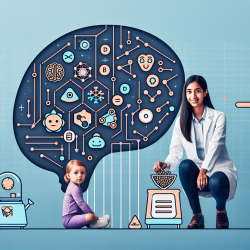Introduction
In the ever-evolving field of speech-language pathology, leveraging data-driven insights can significantly enhance therapeutic outcomes, particularly for children. The research article "Identifying Disease of Interest With Deep Learning Using Diagnosis Code" provides a compelling case for utilizing deep learning models to improve diagnostic accuracy. This blog post will explore how practitioners can apply these insights to advance their skills and improve outcomes for pediatric patients.
Understanding the Research
The study conducted by Cho et al. (2023) introduces a novel deep learning model, the End-to-End Supervised Autoencoder (EEsAE), which predicts diseases using diagnostic codes. This model demonstrated superior performance in identifying co-existing diseases, such as gastric cancer, by analyzing large datasets from the Korean National Health Information Database.
Key findings include:
- The EEsAE model achieved the highest F1-score and area under the curve (AUC) compared to other models like eXtreme Gradient Boosting (XGB) and Naïve Bayes.
- The model identified influential diagnostic codes that significantly impact prediction accuracy, such as iron deficiency anemia and gastroesophageal reflux disease.
Application in Speech Therapy
While the research primarily focuses on medical diagnoses, its implications for speech-language pathology are profound. Here's how practitioners can harness these insights:
- Data-Driven Assessment: Utilize diagnostic codes and deep learning models to identify underlying conditions that may affect speech development, such as neurological disorders or genetic conditions.
- Personalized Therapy Plans: By understanding the co-existence of various conditions, therapists can tailor interventions to address specific needs, improving the efficacy of therapy sessions.
- Predictive Analytics: Implement predictive models to anticipate potential speech and language challenges, allowing for early intervention and better long-term outcomes.
Encouraging Further Research
The study underscores the potential of deep learning in healthcare, but its application in speech-language pathology is still in its infancy. Practitioners are encouraged to explore further research opportunities, such as:
- Investigating the relationship between specific diagnostic codes and speech disorders.
- Developing customized deep learning models for predicting speech and language outcomes in children.
- Collaborating with data scientists to refine models and improve their applicability in therapeutic settings.
Conclusion
By integrating deep learning insights into speech therapy practices, practitioners can enhance their ability to diagnose, predict, and treat speech and language disorders in children. This approach not only fosters better outcomes but also paves the way for innovative research and collaboration in the field.
To read the original research paper, please follow this link: Identifying Disease of Interest With Deep Learning Using Diagnosis Code.










